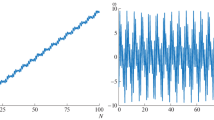Abstract
The paper develops a hamiltonian formulation describing the coupled orbital and spin motions of a rigid Mercury rotation about its axis of maximum moment of inertia in the frame of a 3:2 spin orbit resonance; the (ecliptic) obliquity is not constant, the gravitational potential of mercury is developed up to the second degree terms (the only ones for which an approximate numerical value can be given) and is reduced to a two degree of freedom model in the absence of planetary perturbations. Four equilibria can be calculated, corresponding to four different values of the (ecliptic) obliquity. The present situation of Mercury corresponds to one of them, which is proved to be stable. We introduce action-angle variables in the neighborhood of this stable equilibrium, by several successive canonical transformations, so to get two constant frequencies, the first one for the free spin-orbit libration, the other one for the 1:1 resonant precession of both nodes (orbital and rotational) on the ecliptic plane. The numerical values obtained by this simplified model are in perfect agreement with those obtained by Rambaux and Bois [Astron. Astrophys. 413, 381–393].
Similar content being viewed by others
References
Anderson, J. D., Colombo, G., Esposito, P. B., Lau, E. L. and Trager, G. B.: 1987, 'The mass, gravity field and ephemeris of Mercury', Icarus 71, 337–349.
Balogh, A. and Giampieri, G.: 2002, 'Mercury: the planet and its orbit', Reports Prog. Phys. 65, 529–560.
Beletskii, V. V.: 1972, 'Resonance rotation of celestial bodies and Cassini's laws', Celestial Mech. 6, 359–378.
Bouquillon, S.: 2001, 'Mercury libration: first stage', Journées 2001, Syste`mes de Référence Spatio-Temporels (<nt>Ed.</nt> N. Capitaine), 135–140.
Brouwer, D. and Clemence, G. M.: 1961, Methods of Celestial Mechanics, Academic Press New York.
Burns, T. J.: 1979, 'On the rotation of Mercury', Celestial Mech. 19, 297–313.
Carpentier, G. and Roosbeek, F.: 2003, 'Analytical development of rigid Mercury nutation series', Celestial Mech. Dyn. Astr. 86, 223–236.
Colombo, G.: 1965, Nature 208, 575.
Chapront, J., Chapront-Touzé, M. and Francou, G.: 1999, 'Complements to Moons' lunar librationtheory', Celestial Mech. Dyn. Astr. 73, 317–328.
Deprit, A.: 1967, 'Free rotation of a rigid body studied in the phase plane', Am. J. Phs. 35 (5), 424–428.
Eckhardt, D. H.: 1981, 'Theory of the libration of the Moon', Moon Planets 25, 3–49.
ESA-SCI: 2000, 'BepiColombo, An Interdisciplinary Cornerstone Mission to the Planet Mercury', System and Technology Study Report.
Henrard, J and Schwanen, G.: 2004, 'Rotation of synchronous satellites: Application to the Gazillan, satellites, Celestial Mech. Dyn. Astr. 89, 181–200.
Kinoshita, H.: 1972, 'First-order perturbations of the two finite body problem', Publ. Astron. Soc. Jpn. 24, 423–457.
Migus, A.: 1980, 'Analytical lunar libration tables', Moon Planets 23, 391–427.
Moons, M.: 1982, 'Analytical theory of the libration of the Moon', Moon Planets 27, 257–284.
Moons, M.: 1984, 'Planetary perturbations on the libration of the Moon', Celestial Mech. 34, 263–273.
Peale, S. J.: 1969, 'Generalized Cassini's laws', Astron. J. 74(3), 483–489.
Peale, S. J.: 1972, 'Determination of parameters related to the interior of Mercury,' Icarus 17, 168–173.
Peale, S. J.: 1974, 'Possible histories of the obliquity of Mercury', Astron. J. 79(6), 722–744.
Rambaux, N. and Bois, E.: 2004, 'Theory of the Mercury's spin-orbit motion and analysis of its main librations', Astron. Astrophys., 413, 381–393.
Williams, J. G., Boggs, D. H., Yoder, Ch. F., Ratcliff, J. T. and Dickey, J. O.: 2001, 'Lunar Rotational dissipation in solid body and molten core.' J. Geophys. Res. 106(E11), 27933–27968.
Author information
Authors and Affiliations
Rights and permissions
About this article
Cite this article
D'hoedt, S., Lemaitre, A. The Spin-Orbit Resonant Rotation of Mercury: A Two Degree of Freedom Hamiltonian Model. Celestial Mechanics and Dynamical Astronomy 89, 267–283 (2004). https://doi.org/10.1023/B:CELE.0000038607.32187.d4
Issue Date:
DOI: https://doi.org/10.1023/B:CELE.0000038607.32187.d4




